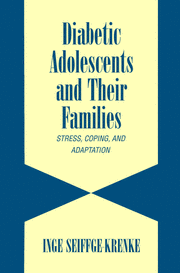Book contents
- Frontmatter
- Contents
- Foreword by Stuart T. Hauser
- Preface
- 1 Epidemiology of Chronic Illnesses in Adolescence
- 2 Coping with Illness in Adolescence: An Overview of Research from the Past 25 Years
- 3 Coping with Diabetes: A Longitudinal Study
- 4 Knowledge of the Illness, Compliance, and Patient–Physician Relationships
- 5 Self-Concept, Body Image, and Perceived Health
- 6 Adolescent, Parental, and Family Coping with Stressors
- 7 Chronic Illness and the Family: The Perspectives of Mothers, Fathers, and Siblings
- 8 Friendships, Romantic Relationships, School, and Career
- 9 Successful Adaptation or the Development of Psychopathology?
- 10 Pathways for Resolving the Dilemma between Developmental Progression and Adaptation to the Illness
- 11 Implications for Prevention and Intervention
- References
- Index
1 - Epidemiology of Chronic Illnesses in Adolescence
Published online by Cambridge University Press: 06 August 2009
- Frontmatter
- Contents
- Foreword by Stuart T. Hauser
- Preface
- 1 Epidemiology of Chronic Illnesses in Adolescence
- 2 Coping with Illness in Adolescence: An Overview of Research from the Past 25 Years
- 3 Coping with Diabetes: A Longitudinal Study
- 4 Knowledge of the Illness, Compliance, and Patient–Physician Relationships
- 5 Self-Concept, Body Image, and Perceived Health
- 6 Adolescent, Parental, and Family Coping with Stressors
- 7 Chronic Illness and the Family: The Perspectives of Mothers, Fathers, and Siblings
- 8 Friendships, Romantic Relationships, School, and Career
- 9 Successful Adaptation or the Development of Psychopathology?
- 10 Pathways for Resolving the Dilemma between Developmental Progression and Adaptation to the Illness
- 11 Implications for Prevention and Intervention
- References
- Index
Summary
Since the beginning of the 20th century, the relative distribution of somatic illnesses in the population has changed. Acute illnesses such as infectious diseases and deficiencies such as malnutrition have lost much of their significance; today, chronic illnesses predominate. Progress in medical knowledge and improvements in living conditions have been responsible for this change. In this chapter, data on causes of death and rates of mortality are presented first, followed by rates of incidence (frequency of newly appearing cases within a certain time period) and rates of prevalence (frequency of an illness in a special population at a certain point in time or over a particular period of time) for chronic physical diseases in adolescence. Finally, an approach to categorizing chronic physical illnesses is presented.
Changes in the Spectrum of Illnesses and Causes of Death
Chronic diseases are the main cause of death in the population today. However, the mortality rates for chronic illness are not as high for adolescent populations as for adult populations. According to the German Federal Bureau of Statistics (Statistisches Bundesamt, 1994), 10- to 20-yearolds show the lowest mortality rates of all age groups. The likelihood of dying in this age range is therefore relatively low, compared with other age groups. In Germany, accidents, particularly those involving motor vehicles, are the major cause of death in this age group, not illness as in adults. Similar trends have been documented for other European countries (Seiffge-Krenke, 1998a).
- Type
- Chapter
- Information
- Diabetic Adolescents and their FamiliesStress, Coping, and Adaptation, pp. 1 - 8Publisher: Cambridge University PressPrint publication year: 2001



